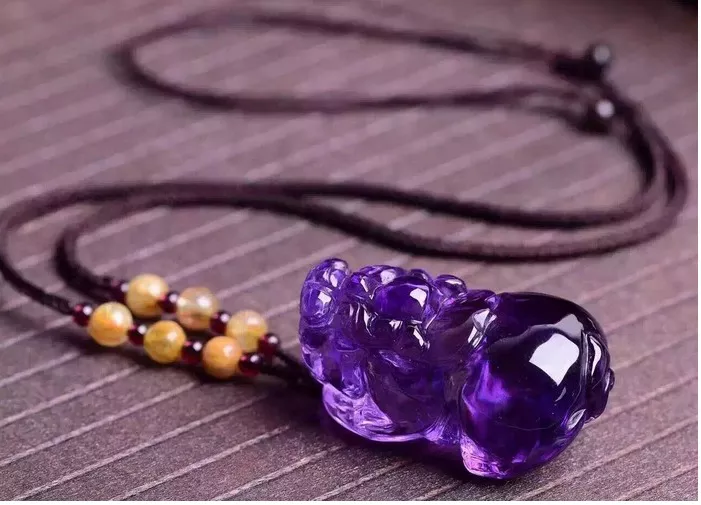Amethyst, a mesmerizing purple gemstone, has captivated humanity for centuries with its stunning beauty and intriguing properties. From ancient civilizations to modern jewelry enthusiasts, this gemstone continues to hold a special place in the hearts of many. In this article, we’ll delve into five fascinating facts about amethyst that showcase its unique characteristics and allure.
1. Ancient Symbolism and Mythology
Amethyst’s rich history is steeped in symbolism and mythology, spanning various cultures and civilizations. The ancient Greeks, for instance, believed that amethyst could protect its wearer from drunkenness, leading to the belief that the gemstone derived its name from the Greek word “amethystos,” meaning “not intoxicated.” According to Greek mythology, amethyst was once a nymph named Amethystos who was transformed into a gemstone by the goddess Artemis to protect her from the advances of Bacchus, the god of wine.
In ancient Egypt, amethyst was associated with protection and was often used in burial rituals to safeguard the deceased on their journey to the afterlife. Similarly, in medieval Europe, the gemstone was believed to possess healing powers and was worn by royalty and clergy members as a symbol of power and spirituality.
2. Geological Origins and Formation
Amethyst is a variety of quartz, which is one of the most abundant minerals on Earth. Its distinctive purple coloration is the result of trace amounts of iron within the crystal lattice, combined with irradiation and the presence of certain trace elements. The intensity of the purple hue can vary significantly, ranging from pale lilac to deep violet, depending on factors such as the concentration of impurities and the conditions under which the crystal formed.
Most amethyst crystals are formed in geodes, which are hollow cavities within rocks that become lined with crystals over time. These geodes typically occur in volcanic rocks such as basalt and are often found in association with other minerals such as agate and calcite. The formation process can take millions of years, with crystals slowly growing as mineral-rich groundwater percolates through the rock, depositing layers of quartz within the geode cavity.
3. Spiritual and Metaphysical Properties
Throughout history, amethyst has been revered for its purported spiritual and metaphysical properties. In various belief systems and practices, this gemstone is associated with qualities such as clarity of mind, emotional balance, and spiritual enlightenment. It is often used in meditation and energy healing techniques to promote relaxation, reduce stress, and enhance intuition.
According to crystal healing practitioners, amethyst is believed to stimulate the third eye chakra, which is associated with insight, intuition, and spiritual awareness. By placing an amethyst crystal on the forehead during meditation, individuals may experience a heightened sense of consciousness and a deeper connection to the spiritual realm.
In addition to its spiritual significance, amethyst is also thought to have protective properties, shielding the wearer from negative energy and psychic attacks. Some people believe that wearing or carrying amethyst can create a protective energy field around the body, helping to ward off negativity and promote a sense of inner peace.
4. Varieties and Color Changes
While amethyst is best known for its characteristic purple color, this gemstone can exhibit a range of hues and variations depending on geological factors and the presence of impurities. One notable variety of amethyst is known as “Ametrine,” which is a combination of amethyst and citrine, another type of quartz. Ametrine displays zones of purple and yellow or orange within the same crystal, creating a striking bicolor effect.
Another interesting phenomenon associated with amethyst is its ability to undergo color changes when exposed to heat or radiation. This process, known as “thermal or irradiation enhancement,” can result in the transformation of amethyst into different colors, including green and yellow. These color-altered varieties are often marketed under trade names such as “green amethyst” or “prasiolite,” although they are technically not true amethysts.
In addition to natural variations, amethyst can also be subjected to treatments such as heating and irradiation to enhance its color or clarity. While these treatments are common in the gemstone industry and generally accepted as long as they are disclosed to consumers, they can affect the value and durability of the stone.
5. Cultural Significance and Modern Uses
Amethyst continues to hold cultural significance in various parts of the world, where it is revered for its beauty and symbolism. In addition to its use in jewelry and adornment, this gemstone plays a role in ceremonial and spiritual practices in many cultures. For example, in Tibetan Buddhism, amethyst is associated with the crown chakra and is used in rituals to promote spiritual awakening and enlightenment.
In modern times, amethyst remains a popular gemstone for jewelry designers and collectors alike. Its rich purple color adds a touch of elegance and sophistication to a wide range of jewelry pieces, including rings, necklaces, earrings, and bracelets. Amethyst jewelry is often worn as a fashion statement or as a personal talisman, with many people choosing pieces that resonate with their individual style and beliefs.
Beyond its aesthetic appeal, amethyst is also used in various industrial applications, thanks to its hardness and durability. It is commonly employed as an abrasive material in grinding and polishing operations, as well as in the production of specialized lenses and optical instruments. Additionally, small amethyst crystals are sometimes used as components in electronic devices and sensors due to their piezoelectric properties.
In conclusion, amethyst is a gemstone with a rich history, diverse geological origins, and a wide range of cultural and practical applications. From its ancient symbolism and mythology to its modern-day uses in jewelry and industry, amethyst continues to captivate and inspire people around the world. Whether appreciated for its spiritual significance, aesthetic beauty, or scientific properties, this enchanting gemstone holds a timeless allure that transcends generations.


